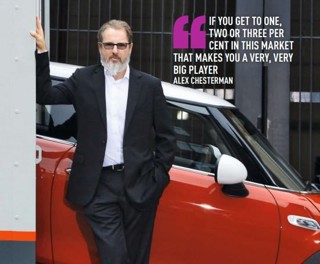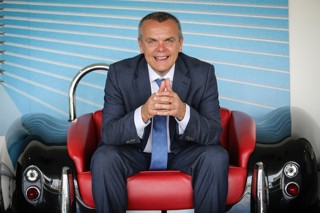The profile of AM100 dealer group Robins & Day has changed a fair bit since James Weston became its chief executive in 2016.
It has gained a fourth vehicle brand – Vauxhall – following the British brand’s acquisition by Robins & Day’s owner, the vehicle manufacturer Groupe PSA.
It has continued to multi-brand a number of its 43 locations to make them more cost-effective and provide broader representation for the Peugeot, Citroën, DS and Vauxhall brands in crucial metropolitan areas. And Weston’s team has continued the work of his predecessor David Peel, now Peugeot UK’s managing director, on improving employee engagement, profitability and customer satisfaction.
The profile of AM100 dealer group Robins & Day has changed a fair bit since James Weston became its chief executive in 2016.
It has gained a fourth vehicle brand – Vauxhall – following the British brand’s acquisition by Robins & Day’s owner, the vehicle manufacturer Groupe PSA.
It has continued to multi-brand a number of its 43 locations to make them more cost-effective and provide broader representation for the Peugeot, Citroën, DS and Vauxhall brands in crucial metropolitan areas. And Weston’s team has continued the work of his predecessor David Peel, now Peugeot UK’s managing director, on improving employee engagement, profitability and customer satisfaction.
This year, Weston has needed to steer the business through one of the most unusual and challenging periods in the UK motor industry’s history.
“Right at the very start (of lockdown) one of my team said to me that we have to learn from this. We’ve taken the approach as a group, right from March, that if we came out of lockdown and just do as we always did then it would be ‘COVID: 1, Robins & Day: 0’. That was never our intention – we hate losing,” said Weston, who has been with the motor retailer since 2001 when he was assistant sales manager at its dealership in Chiswick, west London.
His message to Robins & Day’s senior management team in April, as trading ceased except for key workers, was to determine the group’s strategic advancement under a ‘Faster and Further’ strategy that would shape its progress this decade. They studied each department, identified what was essential for its development, and agreed a timescale to launch.
Then, in late spring, the management team launched a ‘Back to Better Business’ operational plan for all dealerships with three core pillars – eradicating poor performance, eliminating poor processes and better managing any individuals that were underperforming in terms of productivity or abilities.
Weston said rather than being fixated on reacting to the “white noise” of KPI measures, the focus for the Back To Better Business plan shifted onto the areas that create those measures as an output; so identifying which lead measures are needed to reach those lag measures and what good should look like.
His example was setting an aim to sell 1,500 used cars in a week as a lag measure, which can only be achieved if the group first knows what percentage of inventory is in line with the pricing policy, what percentage has been prepared, the quality of the online advertisements and so on, that are the steps to reaching that result.
“Focus on the core lead measures and you’ll drive the output, the lag measures,” he said.
“It meant the top of the business was driving the development and the weight of the business was driving daily business. It really did increase the operational performance.”
Familiar yet different
Weston wanted the business to feel familiar yet different when the bulk of the workforce came back in the summer after being on furlough. It needed to be evident that it had taken a step forward, he said.
And that needs to remain evident. “When COVID does gradually subside and things start to ease, we want to look back and think ‘yes that was a period of a lot of personal hardship and we had people touched by the virus but, importantly, we used that time to reset and restart to make our businesses stronger,” Weston added.
One example of the steps forward is Robins & Day’s connected customer project. Although different approaches by dealer groups include having a central contact centre to manage internet leads or having dedicated staff in dealerships doing the same, Weston sees Robins & Day as taking a hybrid approach.
“Sometimes when you take activities into a contact centre all you can end up doing is taking the inefficiency out of the sales departments and put it into a team sat in a cloud while thinking you’ve made a difference because you have a consistent approach. The reality is, we chase leads but half of those aren’t actually leads.”
Using the example of an online part-exchange valuation query, Weston said the industry’s systems capture their data “and suddenly they’re a lead” when actually the customer is at a particular research stage and purely seeks what they think should be available online at that point.
Send those kind of ‘leads’ to a sales executive, who must secure an appointment for the dealership, and the sales conversion rate will suffer, because the customer is still completing steps in their online research journey.
“That doesn’t make sense. Clearly you want that customer to come through, but the challenge is that we disconnect their journey.”
Weston has talked to staff about ‘domino leads’. He compares the steps involving in selling a car to having to colour in the dots on a domino. He believes if you’re trying to sell a car when there’s only one dot coloured in you’ll be successful far fewer times and it’s likely you’ll discount more to win that sale early because not all the steps have been completed properly.
So he hopes the group’s connected customer approach will help it ascertain that more of those ‘domino dots’ have been done by the customer before there’s an attempt to close the deal.
He said the traditional steps to sell a car haven’t changed fundamentally. The customer’s autonomy to take those steps when and how they wish is what has changed.
Now some of the group’s digital systems have been developed in-house to knit together every touchpoint a customer has across its dealerships, with its website and with the Robins & Day’s ‘active response team’ contact centre together into one journey.
It’s allowing the business to understand the directions consumers take, so the group can plot which step to serve the customer next.
 It can also start to measure consumer activity, such as the average time taken between steps in the research, what next steps the group can successfully prompt the online customer into taking, and how long a lead takes to be converted on average.
It can also start to measure consumer activity, such as the average time taken between steps in the research, what next steps the group can successfully prompt the online customer into taking, and how long a lead takes to be converted on average.
Beforehand, a customer’s steps might be stored separately by four databases for website, dealership, contact centre and central DMS. “Having four bases that don’t talk to each other is deadly,” he said.
Having a single customer view will help the group to tailor the experience to their needs, and the intelligence gathered through the connected customer project will allow the sales staff to become “volume and quality specialists” because some of the tasks that clog their day can be removed. Weston’s dream is to allow them to focus on their product knowledge and expertise in selling, raising that conversion rate.
This is all the more vital because 2020 was the start of an electric vehicle (EV)offensive from Groupe PSA and Weston believes this adds to the pressure on retailers to deliver the right customer experience.
Awareness of EVs is growing among consumers, and his staff must avoid the risk that a customer comes in and knows more about EV ownership than they do.
The term ‘confidence’ came up frequently in Weston’s interview with AM. Not simply as the subject of consumer confidence in their dealer, but as the importance of workforce confidence in their leadership during a crisis.
Weston credits much of the work done over the years on employee engagement as critical in how staff have managed the changes to their work and home life in 2020.
This year more than most, business leaders have needed to project confidence to their teams. Decisions have had to be made without the full facts nor long-term certainty, but amid a crisis teams will look to the leadership for direction.
The dedication, care and commitment staff showed to the group and each other “was quite frankly phenomenal”, Weston said and he is convinced that if Robins & Day had not invested in staff engagement for years, the situation would have been much worse.
Even when the majority of employees were on furlough, Robins & Day’s Yammer social networking platform remained a hive of activity, as staff shared their experiences, home activities, hopes and fears with each other.
Weston provided regular video updates and messages, but said he was particularly touched by the number of personal messages from employees in various levels of the business asking about his own wellbeing.
“When the people in my organisation at any level feel comfortable enough to ask me how I feel in a time like that, it shows we have that transparency within the business… our people are moving with us.”
How confident were the managers?
In July, as the teams had adjusted to the ‘new normal’, Weston asked his managers how confident they were that they could beat the plan for the second half of the year. Some 93% were confident.
“A pivotal part to my group is that we are one, ‘we are Robins & Day’. There’s real belief in our core strategy and direction, and if staff are happy with who they’re working for that shines through to their customers.”
Like many dealer groups, the return from lockdown has been strong. But now the year-end nears, his latest messages for his managers have emphasised the sustainability of their sales performance.
Weston believes that across the industry many businesses have felt the benefits of demand for cars exceeding supply and headcount costs reducing, but they must consider how they can protect the business when conditions change in 2021.
“Supply and demand is totally skewed at the moment. But what do we do when supply increases, or at the end of the year when demand tails off slightly?
Are we still geared correctly in terms of headcount and costs?”
Robins & Day’s dealerships tend to be in high cost, large urban areas, but in the past decade more and more have become multi-marque sites, representing several of the Groupe PSA brands.
This has come from a drive for efficiency – allowing properties to offer a broader range of new and used cars can help to attract more customers and offset the cost base.
Multi-branding is reflected in the group’s management structure too.
Although the strategic team of chief executive, sales director, aftersales director, finance director, head of HR, head of market and chief financial officer oversee the entire business, they sit above four operations directors, each responsible for a region and all the different franchises within it, rather than have directors heading each brand.
Beneath them, general managers are allowed to show a bit of “flair” in their site. Given the different territories its dealerships occupy, Weston wants local management to bring their own touch to each business while following the group’s strategy and programmes.
It all ties back to that crucial staff engagement in a group where care and confidence remain critical.
Login to continue reading
Or register with AM-online to keep up to date with the latest UK automotive retail industry news and insight.






















Login to comment
Comments
No comments have been made yet.